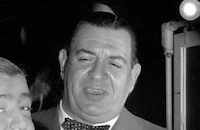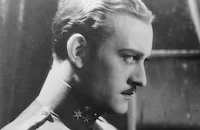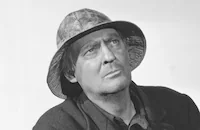The Hollywood Revue of 1929

Brief Synopsis
Cast & Crew
Charles Reisner
Conrad Nagel
Jack Benny
John Gilbert
Norma Shearer
Joan Crawford
Film Details
Technical Specs

Synopsis
The show opens with a minstrel chorus and dance routine, and Jack Benny and Conrad Nagel are introduced as masters of ceremony. Joan Crawford sings "Gotta Feelin' for You," amidst a dance specialty, finishing with the Biltmore Quartet. Charles King does "Your Mother and Mine," before a minstrel chorus, and Conrad Nagel sings "You Were Meant for Me" to Anita Page. Cliff Edwards and his "uke" render "Nobody But You," and William Haines and Jack Benny do a comedy sketch. Bessie Love comes out of Benny's pocket in miniature and with a male chorus sings "I Could Never Do a Thing Like That," climaxed by a dance number. Next, Marie Dressler and Polly Moran in a comedy number sing "For I'm the Queen," and Laurel and Hardy do a sketch as magician. Marion Davies sings "Tommy Atkins on Parade" with a male chorus and does some tap dancing. The Brox Sisters introduce a song and dance ensemble. "The Tableau of Jewels" opens the second act, followed by "The Dance of the Sea," in which Keaton appears. Gus Edwards sings "Lon Chaney" and is followed by the Natova company in an adagio dance. Norma Shearer and John Gilbert appear next in a Technicolor "Romeo and Juliet" balcony sequence with Lionel Barrymore, updated to flapper language. On a glass stage, Cliff Edwards and a dance ensemble appear in "Singin' in the Rain." Two comedy routines follow: "Charlie, Ike and Gus" and "Marie, Polly, and Bess," climaxed by "Strolling Through the Park." The Technicolor finale features Charles King singing "Orange Blossom Time," followed by two dance numbers performed by the Albertina Rasch Ballet. A replica of Noah's Ark and the principals performing "Singin' in the Rain" conclude the show.

Director

Charles Reisner
Cast

Conrad Nagel

Jack Benny

John Gilbert

Norma Shearer

Joan Crawford

Bessie Love

Lionel Barrymore

Cliff Edwards

Stan Laurel

Oliver Hardy

Anita Page

Nils Asther
The Brox Sisters
Natacha Natova And Co.

Marion Davies

William Haines

Buster Keaton

Marie Dressler
Charles King

Polly Moran
Gus Edwards

Karl Dane
George K. Arthur

Ann Dvorak

Gwen Lee
Albertina Rasch Ballet
The Rounders
The Biltmore Quartet
Crew
Louis Alter
John Arnold
Al Boasberg
Martin Broones
Nacio Herb Brown
William Clark
Joe Cohn
David Cox
Jack Cummings
George Cunningham
Richard Day
Gus Edwards
Maximilian Fabian
Joe Farnham
Fred Fisher
Russell Franks
Henrietta Frazer
Arthur Freed
Cedric Gibbons
Joe Goodwin
William S. Gray
Jesse Greer
Ed Haley
Ray Heindorf
Robert E. Hopkins
Robert A. Keiser
Raymond Klages
Ernest Klapholtz
Louis Kolb
Arthur Lange
Sammy Lee
Wesley C. Miller
John T. Murray
John M. Nickolaus
Harry Rapf
Joe Rapf
Andy Rice
Irving Ries
Sandy Roth
Douglas Shearer
Al Shenberg
A. T. Taylor
Joe Trent
Cameron K. Wood

Film Details
Technical Specs

Award Nominations
Best Picture
Articles
The Hollywood Revue of 1929
The Hollywood Revue of 1929 was the first movie of its kind, similar to the stage extravaganzas of Florenz Ziegfeld and George White. Nominated for a Best Picture Oscar, the movie lost to The Broadway Melody (1929), another MGM production to which it is very similar, except that Hollywood Revue has no plotline to connect its skits and songs. The movie was a tremendous hit with both audiences and critics, with the New York Times predicting that such entertaining films would seriously hamper the attendance of live theater.
Almost every big MGM star appears in Hollywood Revue with the notable exception of Greta Garbo, whose contract stipulated that she could only be starred alone in a film or co-starred with a male player. Joan Crawford, in her singing debut, warbles "Got a Feelin' for You" and performs a jazz dance. "Tommy Atkins on Parade" is performed by Marion Davies and a chorus. To scene-stealing effect, Marie Dressler does a bit called "For I'm the Queen" and forms a trio with Polly Moran and Bessie Love to perform "Marie, Polly and Bess." Anita Page sings "You Were Meant for Me."
Acting as emcees of the film are Jack Benny and Conrad Nagel. Since Benny came from vaudeville and Nagel was a movie matinee idol, several of their jokes revolve around the difference between stage performers and film actors. Topical gags include those kidding Prohibition and the advent of sound in the movies. Other comedy routines feature Laurel and Hardy as bumbling magicians and Buster Keaton as a harem girl in a burlesque ballet. In a sequence filmed in Technicolor, John Gilbert and Norma Shearer offer a "slang" version of the balcony scene from Romeo and Juliet, with Lionel Barrymore acting as their director.
Two other segments also are in color: the "Singin' in the Rain" finale and a "Technicolor Ballet." During the latter number, some theaters arranged for the smell of orange blossoms to waft through the audience. Choreographer Sammy Lee, anticipating the work of Busby Berkeley by a few years, created dance routines for the film that were devised to be photographed from overhead.
Producer: Harry Rapf
Director: Charles Reisner
Screenplay: Al Boasberg, Robert E. Hopkins
Cinematography: John Arnold, Max Fabian, Irving Reis
Set Decoration: Cedric Gibbons, Richard Day
Costume Design: David Cox
Original Music: Nacio Herb Brown
Editing: William S. Gray
Principal Cast: Jack Benny (Emcee), Conrad Nagel (Emcee), Ann Dvorak (Chorus Girl); Specialties by Nils Asther, Lionel Barrymore, Joan Crawford, Marion Davies, Marie Dressler, Cliff Edwards, John Gilbert, Stan Laurel and Oliver Hardy, Buster Keaton, Bessie Love, Anita Page, Norma Shearer.
BW & C-119m.
by Roger Fristoe

The Hollywood Revue of 1929
Quotes
Haven't I met you before in Omaha?- Emcee
I never forget a face.- Emcee
The egg trick is OUT! But, nevertheless, we will show YOU how to put a large cake into OBLIVION!- Magician
Ladies and gentlemen -- in fact, all of you. Feeling that you are weary of domestic triangles, we have gone to Europe for our next scene. The locale is Turkey, southern Turkey. You see, Turkey is divided into three zones, namely, the white meat, the dark meat, and the part I always get.- Emcee
Now, I believe that most of you are unfamiliar with the adagio. I know I am. And so are the dancers. And if "adagio" means what I think it does, imagine my embarrassment. Incidentally, this is the 1929 Adagio with the standard gearshift. On with the dance.- Emcee
Now, listen, boyfriend, you have a nice line of chatter but how do I know you care for me in a big way?- Juliet
Trivia
One of the films cited as contributing to the collapse of 'John Gilbert' 's career after audiences heard his high-pitching speaking voice. Apparently, Gilbert's Romeo & Juliet sequence inspired the "talkie disaster" sequence in Singin' in the Rain (1952).
First filmed performance of "Singin' in the Rain". This sequence inspired the opening credits of Singin' in the Rain (1952).
Reportedly features every major MGM star of the day with the exception of Greta Garbo, Ramon Novarro and Lon Chaney.













